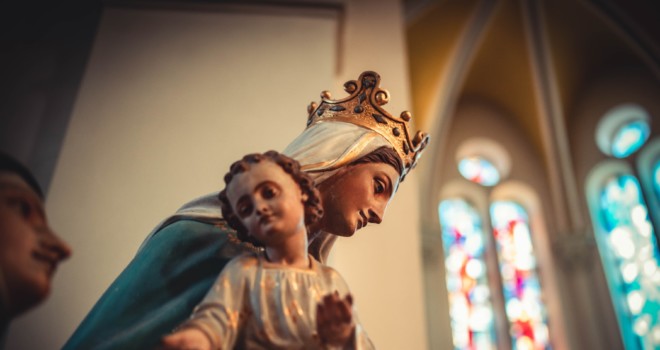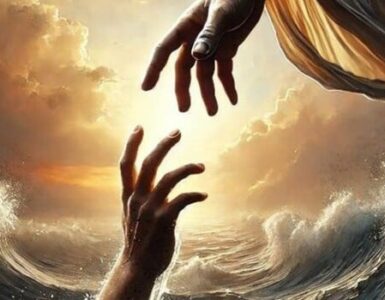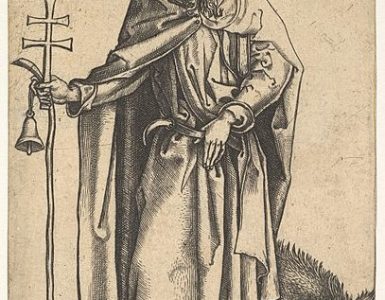Fatima’s Shepherd Girl and the Artist Monk – Part II
This series illustrates the making of the American statue of the Immaculate Heart of Mary in Fatima, which symbolizes “our refuge and the way that leads us to God”. It has decorated the bell tower of the Basilica of the Rosary since 1958. In a unique way, Lúcia dos Santos (1907-2005), the surviving visionary, shaped the design of this piece of art. This second article shows the presence of Fatima in the public life of Lisbon after the Second World War, when Father Thomas McGlynn (1906–1977), an American Dominican, who sculpted the statue, arrived there in February 1947. Lúcia herself encouraged him to write down the story of their cooperation. In McGlynn’s statue, we see how the shepherd girl Lúcia herself saw Our Lady at Fatima.
An American in Lisbon
The Portuguese customs officers were delighted to unexpectedly discover Nossa Senhora de Fátima in the luggage of this American monk, recognizing her immediately.. , They waved him through in friendly fashion; everything seemed to be running as if on greased wheels.
The next day, Father McGlynn expected to receive a letter from the Patriarch of Lisbon on Cardinal Spellmann’s (1889-1967) recommendation to the Bishop of Leiria, which would open Lúcia’s door to him. He planned a stop in Fatima of course, to see the place and to pray where Our Lady spoke to the shepherd children. “Lucy might suggest a few alterations in the details of the statue, but I had little doubt of its meeting with her general approval. I would put them in drawings,” the famous artist monk thought, anticipating an impressed reaction from Lúcia.[1] On his way back to the USA, he planned go via Rome – surely the Holy Father would then bless the model approved by Lúcia.
But his excellent plan was delayed from its very beginning. No hotel available in Lisbon at all, when he arrived! Father McGlynn was supposed to go to Estoril, wherever that was, but soon the American monk found himself enchanted by the old streets of this marvelous city stretched over so many hills, rolling up and down, with its magnificent views of the Portuguese Riviera towards the west. A welcome addition to all these splendors of Old Europe was a breakneck car ride in a taxi on the small winding coastal road at a vast speed that the American monk prodigiously enjoyed.
Thenext morning, as he said mass at the side altar of the San Antonio in Estoril, a baroque sanctuary of the Lisbon-born companion of St. Francis, Fr. McGlynn was struck by the large number of faithful praying the Rosary at such an early hour in a swinging rhythm. It was the first Saturday in February – a Saturday of reparation to the Immaculate Heart of Mary. On July 13, 1917, Maria had announced that she would come again and ask for communions of reparation on the first Saturdays of the month: “You at least try to console me and say that I promise to assist at the hour of death, with the graces necessary for salvation, all those who, on the first Saturday of five consecutive months , shall confess, receive Holy Communion, recite five decades of Rosary, and keep me company for fifteen minutes while meditating on the fifteen mysteries of the Rosary, with the intention of making reparation to me.” This message was given to Lúcia on December 10, 1925 at the Irmãs Doroteias in Pontevedra, Spain.[2]
Fatima – Topic of the Day
The next morning, McGlynn knocks on the door of the Dominican monastery of Santo Corpo in Lisbon. The confreres know nothing of his coming at all – the telegram must have gone astray. Never mind – they improvise a little and the American father finds accommodation in the neighboring hotel. The Patriarch of Lisbon, however, is out of town, he is told. Nobody seems to know when exactly he plans to return. Unexpectedly, but by no means unfortuitously, McGlynn has time to get to know and love Lisbon.
He visits English-speaking families with whom the Dominican convent maintains contact, eyewitnesses to the famous dove miracle that occurred when the statue of Fatima from the Cova da Iria visited Lisbon in a Peregrinatio Mariae. In 1946, on the third centenary of the Reign of the Blessed Virgin, after King João IV (1604-1656) placed his crown at Her feet declaring her Queen of Portugal under the title of the Immaculate Conception and in the year when the personal legate of Pius XII placed a crown on the head of the statue in the Coca da Iria on May 13, three white doves had attached themselves to the statue. They remained with it for many days during the religious celebrations.
Near Fatima, King Alfonso Henrique (1109-1185) won the decisive victory over the Moors in 1147, McGlynn learns. Previously, he vowed to the Blessed Mother to found a monastery for her if she succeeded in capturing the fortress of Santarém, named after the virgin and martyr Iria de Tomar, whose beauty is praised by all sources. In the city occupied for centuries, St. Iria’s intact body was washed up and the basilica named after her contains her tomb. The Cova da Iria, the Trough of Irene, of the ‘Peaceful’, the place of the Marian apparitions, is named after this very Iria. Alfonso gratefully fulfilled his vow and donated the area around Alcobaça to St. Bernard of Clairvaux (1090–1153), the Doctor Marianus and most ardent devotee of Our Lady. Until it was plundered by Napoleonic troops, Alcobaça, a UNESCO World Heritage Site since 1989, was one of the largest and richest abbeys in the Occident and for centuries the spiritual and intellectual center of Portugal. Her future triumph that Our Lady has promised in Fatima has had predecessors in history.
In the evening, McGlynn sits with half a dozen Irish brethren who tease him good-naturedly about his American accent. Having their blood, if not their brogue, he replies in kind, demanding: “The question is: Who has the accent?” McGlynn insists that the pure American pronunciation, free of regional pronunciations, is superior to the rendition given to his mother tongue in any country in the world. The confreres also tell him about the wonderful healings in Fatima, which they themselves witnessed , and the many conversions they experienced as confessors. On his return to the hotel he notes: “The room was clean, but it was an icebox. I sat on the bed, still wearing my topcoat, to say my Office by the light of a small, unshaded bulb”.
Unexpected Controversies
Surprisingly for McGlynn, controversies about Fatima are emerging among his confreres. Of course, they have no doubts about the apparitions of 1917 and the Miracle on October 13. But what about the details that have become known since 1942? “We have Lucy, why do we need the pope?” a priest interjects. He was referring ironically to what seemed to him a complication of devotion brought about by Fatima. He seemed to resent the novelty that he regarded as inherent in such things as Communions of Reparation of the Five First Sundays, the consecration of Russia to the Immaculate Heart, and the prayers taught by an angel and by Our Lady. “Our position on Fatima must be determined not by our preferences but by facts,” the clear-sighted American Dominican kindly corrects his Irish confrere. “The important question is not whether we like the revelations of Fatima, but whether there were true revelations at Fatima”.
The conversations reflect theses of the Belgian Jesuit Édouard Dhanis (1902-1978), who in the mid-1940s postulated two complexes, Fatima I and II, and contrasted them. While the supernatural character of the events of 1917 must be acknowledged, Dhanis considers the “mystery”, the veneration of the Immaculate Heart of Mary, the desire of the consecration of Russia to this Heart, and the apparitions of angels to be unreliable. If he were right, Fatima would be “theologically gutted”. The devout Dominicans become thoughtful and decide to send their confrere Gerard Gardner with Father McGlynn to Lúcia to bring clarity to their convent. He could also translate. (The basis for Dhanis’ arguments was to be eliminated by the long overdue critical edition of Sr. Lúcia’s Memoirs that appeared in 2016 and its scholarly apparatus.
The audience with the patriarch is continually delayed. A white-haired Portuguese monsignor in the bishop’s palace, however, unsettles the confident artist monk for the first time: “Incidentally, the monsignor was not overwhelmed by the beauty of my little statue,” McGlynn observes.
Audience with the Patriarch
Finally, Father McGlynn was received by Manuel Gonçalves Cardinal Cerejeira (1888-1977), Archbishop and Patriarch of Lisbon. At the Second Vatican Council, he would be close to the Coetus Internationalis Patrum, of which Cardinal Spellman and Archbishop Marcel Lefebvre (1905-1991) were members. The New York Cardinal had already informedCerejeira of McGlynn’s intent, and the Archbishop was not only happy to recommend to the Bishop of Leiria McGlynn’s wish to ask Lúcia for her opinion on his model, but also to answer questions about the apparitions. The Patriarch described how profoundly and positively Fatima had transformed the political situation in Portugal and how blessed the consecration of the country to the Immaculate Heart of Mary in 1931 had been.
The American Dominican also learned how the rather late records of Lúcia came about. The decisive impulse came from the exhumation of Jacinta in 1935. When her body, especially her tender face, was found uncorrupted, a photograph was sent to Lúcia. Her reply letter describes the virtues of her friend and expresses her conviction of Jacinta’s sanctity. This sensitizes the bishop of Leiria. It is possible that much has remained hidden over all these years. Committed in obedience, Irmã Dores, as she was called now, began to write her memoirs.
The second part of the “Secret of Fatima” contains a prediction about the outbreak of the Second World War, which Lúcia received in 1917, but only became known in 1942, after the outbreak of the war. McGlynn addresses a problem that does not only concern him: “Is it possible to prove that the prediction was indeed made in 1917?” In early February 1939, he himself received a copy of a letter that Bishop of Leiria had received from Lucy, McGlynn learned from the Patriarch: “The war is imminent,” it said. “The sins of men will soon be washed in their own blood. Those nations will suffer the most in this war, which tried to destroy the Kingdom of God. Portugal will suffer some of the consequences of war, but because of the consecration of Portugal to the Immaculate Heart, the country will be saved from the horrors of war”. WWII began with the German attack on Poland on September 1, 1939.
Consecration of World
The famous radio address of Pius XII on October 31, 1942, in which he consecrated the world to the Immaculate Heart of Mary, was another theme. The consecration had been made based on a request by Lúcia to the pope. In doing so, she had asked for explicit mention of Russia in the formula for consecration, which, as is known, was not made. A special grace that would be granted precisely because of this was a shortening of the war, Lúcia wrote. If the Holy Father wanted to see an example of the effect of the blessing of a consecration with the mention of Russia, he could look to Portugal. However, the patriarch did not seem to know anything about a certain form of consecration of Russia.
At the end of the audience, the Patriarch compared the Mission of Fatima with Paray-le-Monial. It was in this place that Jesus had appeared to St. Margaret Mary Alacoque OVM (1647-1690) and had asked her to spread the veneration of His Sacred Heart from December 27, 1673. What Paray meant for the veneration of the Sacred Heart of Jesus, Fatima would be for the Immaculate Heart of Mary, Cerejeira was convinced.
With the Bishop of Fatima
On the next morning, the wheezing and clanging of small locomotives resounded from the tiled walls in the Estação Rocio as passengers threw wicker valises up the high steps of cars and clambered aboard. In about three hours Fr. McGlynn and Fr. Gardiner were at the station marked “Leiria”, a flat city of white and ochre buildings, marked impressively by a steep cliff that rises abruptly from its center, crowed with the parapets of an ancient Moorish castle.
Dom José Correia da Silva (1872-1957), Bishop of Leiria-Fatima from 1920 until his death, could only move painfully when he entered to greet the monks – consequences of the torture he suffered under the Freemasons who ruled Portugal when Our Lady appeared. He granted the wish to visit Irmã Dores, but made an interview about the apparitions dependent on the approval of the Mother Provincial. As for the model, he only says that the face is too old, but apologizes immediately for the spontaneous comment.
The bishop remarked that Lucy did not like the statue at the Sanctuary apparition site, which is so greatly venerated, but added that the people did and, therefore, it could not be changed. The Portuguese carver José Ferreira Thedim (1892-1971) had created this statue from Brazilian cedar wood. He himself was greatly attached to that image not only because of its typical Portuguese character but particularly because of the profound impression it had made upon the people of Portugal and its intimate association with Our Lady of Fatima throughout the years when Lucy, because of her seclusion, was unable to pass judgement upon any image of Our Lady of Fatima.
Even among the bishop’s polite seminarians, however, the artist monk did not receive any compliments for his own model. Only one ventured a mild expression of satisfaction “with the statue’s simplicity” …
✠
Editor’s note: Editorial assistance was kindly provided by Jane Stannus, a journalist and translator. She is a regular contributor to The Spectator USA. Her work has also appeared in Crisis Magazine, the Catholic Herald, Critic Magazine and the National Catholic Reporter.
This article is the first part in a weekly series on Fr. McGlynn and the work of Our Lady of Fatima. Check back each Friday for more info about how Our Lady of Fatima inspired an artist at her shrine.
Sources and quotations for this include the book by Sr. Lucía dos Santos, Fatima in Lucia’s own Words. As well, quotations and the story of Fr. McGlynn can be found in the book, Vision of Fatima, which is available through Sophia Institute Press.
Photo by Conscious Design on Unsplash













